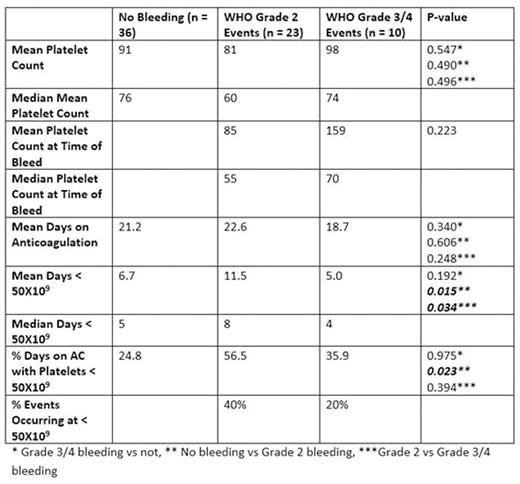Abstract
Introduction: Patients undergoing curative-intent chemotherapy and/or hematopoietic stem cell transplant (HSCT) for hematologic malignancy frequently experience prolonged periods of thrombocytopenia yet remain at high risk of venous thromboembolism (VTE). Data to guide management of thrombosis during these periods are sparse.
Methods: We performed a retrospective chart review of cases of venous thrombosis, diagnosed between January 1, 2009 and December 31, 2014, during which the patient also experienced a ≥5-day period of moderate to severe (platelets <50x109)treatment-related thrombocytopenia within 30 days of diagnosis. Charts of patients with diagnosis code for both venous thrombosis and stem cell transplant and/or acute leukemia were identified and then screened for inclusion. Inclusion criteria were: age ≥ 18 years old, new diagnosis of acute VTE and ≥ 5 days of treatment-related thrombocytopenia (platelet count < 50x109 in the absence of transfusions) while undergoing HSCT for a hematologic malignancy or other curative-intent therapy for acute leukemia within 30 days of VTE diagnosis. Patients were excluded if records were not available for a portion of this thrombocytopenic period. Charts were reviewed for diagnostic and treatment information, including management of anticoagulation, use of platelet transfusions, bleeding events and thrombotic events.
Results: Eighty-three individual events were identified in 79 patients during the identified time period. Sixty-four of these events were catheter-associated thromboses (CAT), 11 were lower extremity deep venous thromboses (DVT) and 8 were pulmonary emboli (PE). In 80% (n = 66) of cases patients were started on anticoagulation (AC) at the time of diagnosis. Twenty-seven (42%) patients with CAT underwent catheter removal as part of initial treatment, 3 (5%) underwent catheter removal prior to diagnosis. Among patients receiving anticoagulation, 92% (61) had a stated platelet transfusion threshold of ≥ 50x109 and only 3 (4.5%) had a stated goal < 50x109. Mean and median platelet counts on treatment and at time of bleed are shown in the table. A percentage of days during which a patient experienced a platelet count <50X109 appeared to be associated with WHO Grade 2 but not Grade 3 or 4 bleeding. Eight patients experienced transfusion reactions (7 cases of hives and one febrile non-hemolytic transfusion reaction) and 25 experienced volume overload that may have been associated with or worsened by platelet transfusions. Ten patients discontinued anticoagulation because the platelet count could not be maintained above the stated threshold. Four patients experienced progression of thrombosis and one patient with CAT developed a possible/probable PE.
Conclusions: In the absence of evidence to guide management, the majority of providers in our institution maintain a platelet transfusion threshold of ≥ 50x109 for patients undergoing anticoagulation during periods of treatment-related thrombocytopenia. While patients who experienced a platelet count below this goal for > 5 days had higher rates of minor (Grade 2) bleeding, increased rates of clinically significant (Grade 3/4 bleeding) were not observed. Patients experienced a number of negative effects potentially related to transfusions, including transfusion reactions and volume overload and, in some cases, early discontinuation of anticoagulation due to difficulty adhering to the stated platelet goal. Our study highlights the need for future trials designed to identify the optimal platelet transfusion threshold for patients who require anticoagulation.
Gernsheimer:Amgen Corporation: Consultancy, Honoraria; National Heart Lung and Blood Institute: Research Funding; Momenta Pharmaceuticals: Consultancy; Syntimmune: Consultancy; UCB Bioscience: Consultancy. Garcia:Pfizer: Consultancy; Boehringer Ingelheim: Consultancy; Daiichi Sankyo: Consultancy, Research Funding; BMS: Consultancy; Janssen: Consultancy, Research Funding.
Author notes
Asterisk with author names denotes non-ASH members.


